Benign and Malignant Ovarian Disease
Inflammatory Conditions
- Pelvic Inflammatory Disease (PID)
- Pathophysiology
- ascending infection of the upper female genital tract
- involves the uterus, fallopian tubes, and ovaries
- sexually transmitted disease caused by N. gonorrhoeae or C. trachomatis
- long-term sequelae includes infertility, chronic pelvic pain, and increased risk of ectopic pregnancy
- Clinical Presentation
- fever > 102° is common
- pelvic and lower abdominal pain is usually bilateral, but may also be limited to one side
- physical exam typically demonstrates cervical motion or adnexal tenderness
- pus may be seen at the cervical os
- in unclear cases, transvaginal ultrasound may reveal thickened fluid-filled tubes
- Management
- antibiotics active against N. gonorrhoeae or C. trachomatis (cefoxitin + doxycycline e.g.)
- laparoscopy occasionally will be necessary to rule out appendicitis or other abdominal pathology
- laparoscopic findings consistent with PID include swollen erythematous tubes with exudates
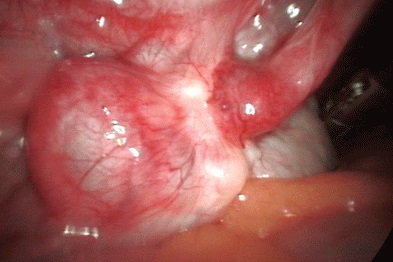
- Tubo-Ovarian Abscess (TOA)
- Etiology
- inflammatory mass involving the fallopian tube and ovary
- may also involve adjacent structures such as the bladder or bowel
- occurs as a complication of pelvic inflammatory disease
- Clinical Presentation
- fever, elevated WBC, lower abdominal pain, and an adnexal mass are the classic symptoms
- may also present with sepsis and peritonitis if the abscess ruptures
- Diagnosis
- transvaginal ultrasound, CT, or MRI can all identify a TOA
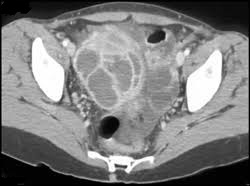
- Management
- Premenopausal Patients
- most hemodynamically stable premenopausal patients with unruptured abscesses < 7 cm in diameter
can be successfully managed with antibiotics alone
- abscesses ≥ 7 cm will require an image-guided drainage procedure or surgical incision + drainage
- Postmenopausal Patients
- there is a high rate of malignancy in this patient group
- most will require surgical exploration with the possibility of a full staging procedure
- a frozen section of the adnexal mass should be performed
- Ruptured TOA
- requires emergency exploration
- a salpingo-oophorectomy is the standard approach for unilateral disease
- for postmenopausal women, a complete TAH-BSO is the procedure of choice
Ovarian Masses
- Benign Lesions
- may be found incidentally at the time of laparotomy or laparoscopy
- Ovarian Cysts
- Simple Cysts
- if the cyst is > 5 cm or symptomatic, aspiration or fenestration is easily performed open or
laparoscopically
- fluid and cyst wall should be sent to pathology
- in the postmenopausal age group, oophorectomy should be considered

- Cystadenomas
- have both cystic and solid components
- serous cystadenomas and mucinous cystadenomas are the most common pathologies
- benign lesions with an excellent prognosis
- peak incidence is between ages 50 - 60
- may be asymptomatic or cause mass-effect symptoms
- average size is 10 cm
- cystectomy should be considered in premenopausal women
- salpingo-oophorectomy is preferred in postmenopausal women
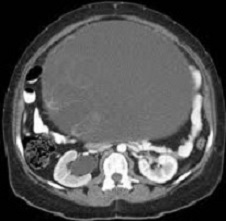 Mucinous Cystadenoma
Mucinous Cystadenoma
- Endometrioma
- dark fluid-filled cavity originating within the ovary (‘chocolate’ cyst)
- may be a source of chronic pelvic pain, infertility, decreased ovarian function, and increased
risk of ovarian cancer
- observation and medical management are usually ineffective
- oophorectomy should be reserved for postmenopausal women
- premenopausal women should have an ovarian-sparing endometrioma excision by a specialist
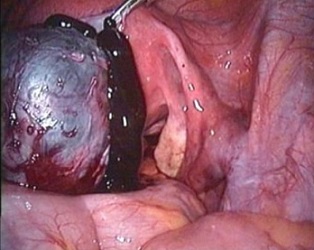
- Brenner Tumors
- also known as a transitional cell tumor since histologically it resembles urothelium
- often found incidentally at laparotomy
- peak incidence is between ages 60 - 70
- most tumors are < 2 cm in size and are benign
- treatment is salpingo-oophorectomy, primarily for histologic confirmation

- Ovarian Cancer
- Incidence
- median age at diagnosis is 63
- 85% of cases are sporadic; 15% are hereditary
- BRCA1 carriers have a lifetime risk of 40% - 60%
- BRCA2 carriers have a lifetime risk of 15% - 45%
- HNPCC carriers have a 7% lifetime risk
- Pathology
- ovarian cancers may originate from epithelial cells, germ cells or stromal cells
- majority originate from epithelial cells
- primary peritoneal cancers are classified and treated as epithelial ovarian cancers
- epithelial cell tumors spread along peritoneal surfaces and through the lymphatics; visceral metastases
are uncommon
- Clinical Manifestations and Diagnosis
- early tumors are asymptomatic
- advanced tumors produce non-specific symptoms: early satiety, increasing abdominal distention,
vague abdominal pain
- physical exam may reveal a pelvic mass or ascites
- US will characterize the pelvic mass
- CT scan may detect ascites or metastatic disease
- CA-125 is usually, but not always, elevated
 Ovarian Carcinomatosis
Ovarian Carcinomatosis
- Surgery
- 3 primary objectives: make a histologic diagnosis, complete staging, optimal debulking
- also used to palliate complications, particularly bowel obstructions
- Operative Staging
- performed through a long midline incision
- visceral and parietal surfaces are inspected for metastases
- total omentectomy is performed, including the gastrocolic omentum
- ascites is collected and sent for cytology
- if no ascites is present, peritoneal washings are obtained from the pelvis, paracolic gutters,
and subdiaphragmatic areas
- hysterectomy and bilateral salpingo-oophorectomy
- retroperitoneal and pelvic lymph node dissections
- random peritoneal biopsies of uninvolved areas (diaphragm, paracolic gutters)
- Cytoreduction (or Debulking)
- surgical goal is complete removal of all disease
- if complete removal is not possible, there is a survival advantage if the tumor can be optimally
debulked (no residual lesions > 1 cm)
- bowel resection, splenectomy are indicated if they lead to optimal debulking
- for mucinous tumors, an appendectomy is performed to rule out metastases from an appendiceal
cancer
- if the tumor cannot be optimally debulked, it is reasonable to close, treat with systemic
chemotherapy, and then perform an ‘interval’ cytoreduction
- secondary cytoreduction can also be considered for recurrent disease
- Adjuvant Chemotherapy
- platinum and taxane-based systemic chemotherapy is standard for advanced stage disease
- if the patient has been optimally debulked, then intraperitoneal chemotherapy provides a significant
survival advantage
- Metastatic Lesions
- common site of metastasis from other primary tumors
- colon, stomach, and breast are the most common primary sites
- most are detected on surveillance imaging
- both ovaries are involved in more than 50% of cases
- oophorectomy should be offered if the ovaries are the only site of metastatic disease
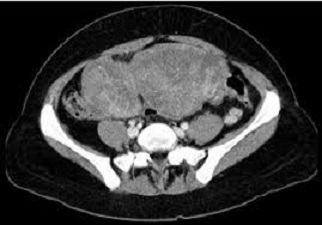 Ovarian Metastasis - Krukenberg Tumor
Ovarian Metastasis - Krukenberg Tumor
Ovarian Anatomy
- Blood Supply
- uterine artery and veins are contained in the infundibulopelvic (suspensory) ligament
- the ureter is also contained in this ligament
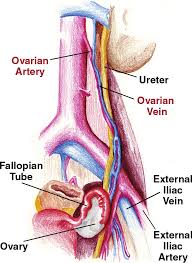
- Salpingo-Oophorectomy
- the tube and ovary are lifted up to expose the infundibulopelvic ligament
- a window is made in the peritoneum, and the ovarian vessels are isolated, clamped, and suture ligated,
carefully visualizing and protecting the ureter
- the broad ligament is divided up to the insertion of the ovarian ligament and fallopian tube
- the ovarian ligament and tube are then ligated and divided

References
- Schwartz, 10th ed., pgs pgs 1698 – 1704
- Sabiston, 20th ed., pgs pgs 2043 – 2047
- UpToDate. Management and Complications of Tubo-ovarian Abscess. Richard H. Beigi. May 22, 2020. Pgs 1 – 24









